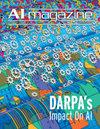预测分析与跨学科框架在促进多慢性病患者为中心的护理:趋势,挑战和解决方案
IF 2.5
4区 计算机科学
Q3 COMPUTER SCIENCE, ARTIFICIAL INTELLIGENCE
引用次数: 1
摘要
上下文。这篇评论是基于一种创新的方法来发展预测分析。它集中于通过整合所有类型的数据集来开发慢性病不同阶段的预测模型,为理论驱动的数据仓库添加各种新功能,创建特定目的的预测模型,并基于生物医学进化学习平台集成慢性病进展的多标准预测。在合并基于从慢性疾病进展预测因子建模中识别的风险因素的跨中心数据库后,合作研究者可以对预测模型进行多中心验证,并进一步开发临床决策支持系统,并结合患者护理共享决策特征的可视化。学习问题。卫生服务管理研究的成功取决于模式检测的稳定性和从大数据到知识的慢性病研究制定的病种分类的有用性。然而,需要具有多波预测因子和结果的纵向观测来捕捉多慢性疾病的演变。动机。通过大数据分析和进一步验证,可以估计出过渡概率。模拟或预测模型可以产生一个有用的解释终末期疾病的发病机制或结果。因此,可以系统地设计和执行以患者为中心的干预措施的临床决策支持系统。方法。提出了一种针对多长期条件的自定义算法,并结合了面向约束的推理方法。基于因果调查的理论规范,我们可以减轻多重混杂因素对患者护理结果决定因素进行评估研究的影响。这就是我们认为在预测分析的表述中避免黑箱表达式的机制。剩下的任务是收集新的数据来验证所提出和验证的预测方程的实际效用。更具体地说,这包括指导未来慢性病和护理管理研究的两种方法:(1)开发生物医学进化学习平台,预测不同阶段多慢性疾病的风险,特别是预测2型糖尿病患者的微观和宏观心血管并发症,以进行多学科护理;(2)针对多慢性疾病高危人群制定相应的规范性干预服务,如以患者为中心的护理管理干预。结论。该评论指出了开展创新的基于人工智能的医疗保健研究的趋势、挑战和解决方案,这些研究可以提高对从糖尿病到其他慢性多慢性疾病的疾病状态转变的理解。因此,可以进一步制定更好的预测模型,将护理管理研究从归纳(解决问题)扩展到演绎(基于理论和假设检验)的查询。本文章由计算机程序翻译,如有差异,请以英文原文为准。
Predictive Analytics with a Transdisciplinary Framework in Promoting Patient-Centric Care of Polychronic Conditions: Trends, Challenges, and Solutions
Context. This commentary is based on an innovative approach to the development of predictive analytics. It is centered on the development of predictive models for varying stages of chronic disease through integrating all types of datasets, adds various new features to a theoretically driven data warehousing, creates purpose-specific prediction models, and integrates multi-criteria predictions of chronic disease progression based on a biomedical evolutionary learning platform. After merging across-center databases based on the risk factors identified from modeling the predictors of chronic disease progression, the collaborative investigators could conduct multi-center verification of the predictive model and further develop a clinical decision support system coupled with visualization of a shared decision-making feature for patient care. The Study Problem. The success of health services management research is dependent upon the stability of pattern detection and the usefulness of nosological classification formulated from big-data-to-knowledge research on chronic conditions. However, longitudinal observations with multiple waves of predictors and outcomes are needed to capture the evolution of polychronic conditions. Motivation. The transitional probabilities could be estimated from big-data analysis with further verification. Simulation or predictive models could then generate a useful explanatory pathogenesis of the end-stage-disorder or outcomes. Hence, the clinical decision support system for patient-centered interventions could be systematically designed and executed. Methodology. A customized algorithm for polychronic conditions coupled with constraints-oriented reasoning approaches is suggested. Based on theoretical specifications of causal inquiries, we could mitigate the effects of multiple confounding factors in conducting evaluation research on the determinants of patient care outcomes. This is what we consider as the mechanism for avoiding the black-box expression in the formulation of predictive analytics. The remaining task is to gather new data to verify the practical utility of the proposed and validated predictive equation(s). More specifically, this includes two approaches guiding future research on chronic disease and care management: (1) To develop a biomedical evolutionary learning platform to predict the risk of polychronic conditions at various stages, especially for predicting the micro- and macro-cardiovascular complications experienced by patients with Type 2 diabetes for multidisciplinary care; and (2) to formulate appropriate prescriptive intervention services, such as patient-centered care management interventions for a high-risk group of patients with polychronic conditions. Conclusions. The commentary has identified trends, challenges, and solutions in conducting innovative AI-based healthcare research that can improve understandings of disease-state transitions from diabetes to other chronic polychronic conditions. Hence, better predictive models could be further formulated to expand from inductive (problem solving) to deductive (theory based and hypothesis testing) inquiries in care management research.
求助全文
通过发布文献求助,成功后即可免费获取论文全文。
去求助
来源期刊

Ai Magazine
工程技术-计算机:人工智能
CiteScore
3.90
自引率
11.10%
发文量
61
审稿时长
>12 weeks
期刊介绍:
AI Magazine publishes original articles that are reasonably self-contained and aimed at a broad spectrum of the AI community. Technical content should be kept to a minimum. In general, the magazine does not publish articles that have been published elsewhere in whole or in part. The magazine welcomes the contribution of articles on the theory and practice of AI as well as general survey articles, tutorial articles on timely topics, conference or symposia or workshop reports, and timely columns on topics of interest to AI scientists.
 求助内容:
求助内容: 应助结果提醒方式:
应助结果提醒方式:


